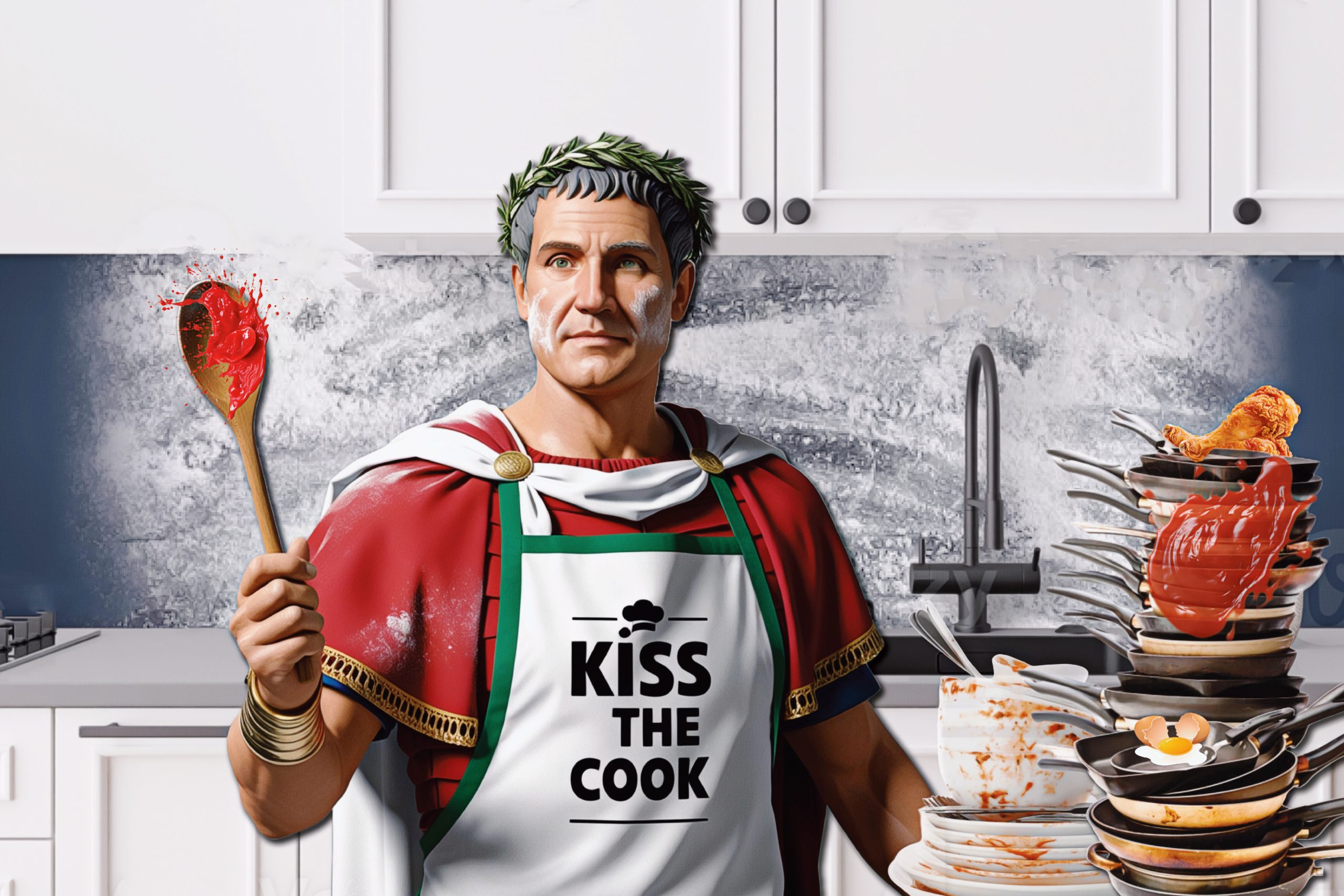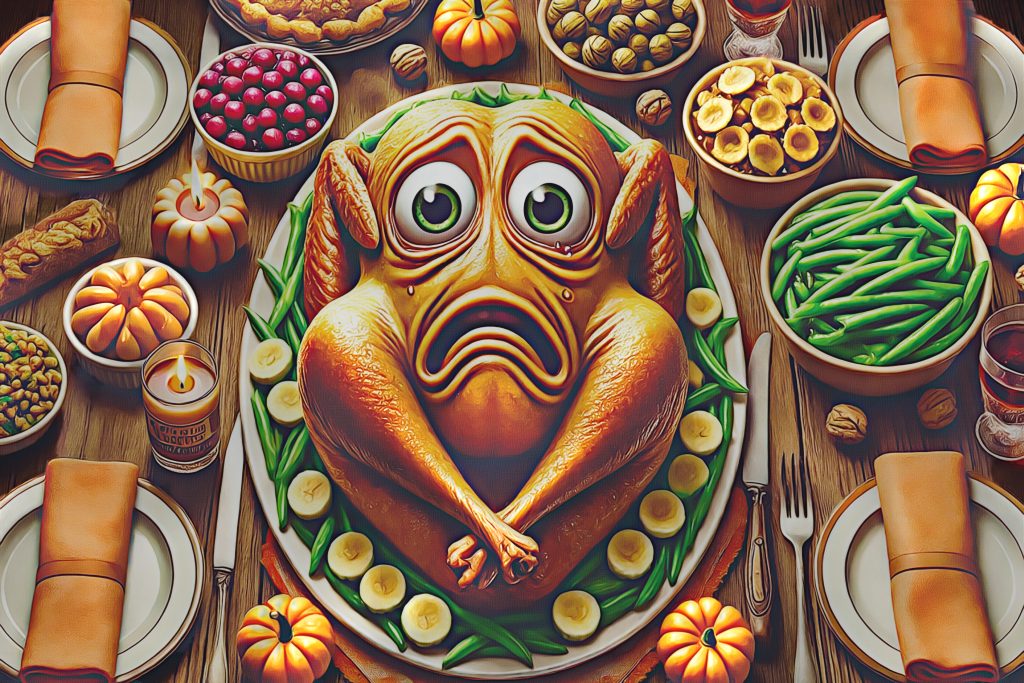Come with me on a little foodie trip back in time. Imagine the bustling streets of Ancient Rome—vendors shouting, carts clattering over cobblestone roads, and the warm, savory smells of freshly baked bread wafting through the air. It’s early morning, and the sun is just starting to rise, casting a golden hue over the city’s ancient stone buildings.
But before we can totally immerse into our foodie fantasy trip, we need to know what Ancient Rome actually looked like.
Every Roman, from the wealthy elite to the common laborer, is beginning their day with a trip to the local markets.
These open-air markets were more than just a place to grab food—they were a social hub, where Romans caught up on juicy gossip and made sure they were seen by all the right people.
There were no grocery stores or butchers as we know them today. Instead, the Romans relied on daily trips to these open markets, where farmers, bakers, and fishermen sold their wares fresh from the countryside and sea.
These markets were the real deal, dishing out the Ancient Roman version of fast food and, yep, even so-called “processed” food, not really, but you get the idea.
The vibe was lively, filled with chatter and bartering, as Romans picked up staples like bread, olive oil, vegetables, and sometimes, meat or fish. Romans believed in eating fresh food, so many households did their shopping daily, ensuring that meals were always made from the freshest ingredients. While the wealthy might send their servants to do the shopping, most Romans—particularly women—made the trip themselves.
Walking through these streets, you’d be hit with the aromas of garlic, herbs like oregano and thyme, and the tang of Garum, their beloved fish sauce.
And speaking of Garum, here’s how you can make that beloved sauce.
The flavors of Roman food were simple but bold—earthy, hearty, and, depending on your status, either rustic or lavishly complex. Very similar to how modern-day Italian food is prepared and eaten.
The average Roman citizen was fit but not muscular like a gladiator. Their diet was heavy on carbs—think bread, barley, lentils, and vegetables—with meat reserved for special occasions. This carb-heavy diet kept them fueled for labor-intensive tasks, but it was surprisingly balanced, with fiber and essential nutrients from fruits, vegetables, and legumes. As we’ll see, food was more than just sustenance in Ancient Rome—it was a key part of daily life, culture, and even entertainment.
Wait, so carbs aren’t the enemy after all? Things are about to get interesting, so let’s dive in.
Today, we’re introducing you to Ancient Roman cuisine—from gladiator fuel to feasts, and everything in between. We’re taking a deep dive into Roman food culture, serving up “modern” takes on some of the most iconic dishes that powered this ancient civilization. Whether you’re curious about the fast, hearty meals that kept gladiators going, the simple but satisfying dinners of everyday Romans, or the lavish feasts that defined the elite, we’ve got a recipe that’ll bring a little piece of Rome right into your modern kitchen.
From snacking at the Colosseum (think “Gladiator Fast Food”) to rustic home-cooked dinners and over-the-top banquets, we’ll explore how the Romans crafted their meals, what they ate, and why food was such a key part of their identity. So, are you ready to toss on a toga and take a culinary dive into Rome’s past? Let’s jump in.
For the average Roman, food was all about practicality. They needed meals that were filling, affordable, and easy to prepare. Bread was a staple, along with porridge, legumes, vegetables, and olive oil. Meat was a luxury for most, reserved for festivals or special occasions. Despite their humble ingredients, Roman meals were anything but bland. They used herbs, honey, and garum (a fermented fish sauce) to season their food, making even the simplest dishes flavorful.
Here’s a typical recipe that would have been enjoyed by the average Roman:
Moretum (Roman Cheese Spread)

This ancient Roman dish was a simple but flavorful spread made from cheese, garlic, and herbs.
Ingredients:
- 1 cup ricotta cheese
- 2 cloves garlic, minced
- Fresh parsley, cilantro, or mint
- Olive oil
- Salt and pepper to taste
Instructions:
- In a bowl, mix the ricotta cheese with the minced garlic.
- Chop the fresh herbs finely and stir them into the mixture.
- Drizzle olive oil over the top and season with salt and pepper.
- Serve with bread for a simple yet hearty meal.
And if you’re craving a little extra help whipping up your ancient cheese spread, check out this in-depth video—it’s got a slightly different take on the recipe and a side of history to boot.
In the bustling markets and eateries of Ancient Rome, meat wasn’t as common as it is today, but when Romans ate it, they made it count. One of the more popular street foods was Isicia Omentata, which you could call the Roman ancestor of the hamburger. But unlike today’s quick-serve fast food, this dish was made with care and a mix of spices, herbs, and even pine nuts to elevate its flavor.
Romans didn’t necessarily grind the meat themselves. Depending on their status, this could have been done by butchers or specialized vendors in the market. However, in smaller homes or for those cooking on a budget, people might have prepared the meat by hand, chopping it finely or using rudimentary tools to break it down.
The patty was then cooked over an open flame, either grilled or fried in olive oil, giving it a rich, flavorful exterior. They would have served it alongside bread, not in a bun like we have today, but with hearty loaves baked in wood-fired ovens. This was a simple, filling meal that many Romans could enjoy, especially those frequenting the popinae (taverns) or grabbing street food.
Here’s a nifty way you can easily recreate this dish at home today.
Isicia Omentata (Roman Meat Patty)

Ingredients:
- 1 lb ground beef or lamb
- 1 tsp black pepper
- 1 tbsp garum (or a pinch of salt if unavailable)
- 1 tbsp pine nuts
- Fresh coriander, chopped
- 1 egg, beaten
- Olive oil for frying
Instructions:
- In a bowl, combine the ground meat, black pepper, garum, pine nuts, chopped coriander, and beaten egg.
- Form the mixture into small patties.
- Heat olive oil in a pan over medium heat.
- Fry the patties until golden brown on both sides, ensuring they’re cooked through.
- Serve alongside rustic bread or with simple vegetables for an authentic Roman meal.
In ancient Roman times, most food was cooked over an open flame or in wood-fired ovens. The Isicia Omentata would have been grilled or pan-fried in olive oil, which added richness to the dish. There were no fancy grills like today—just simple pans or stones heated by fire.
And here’s an even more ancient twist on the Roman “hamburger.”
And if beef isn’t your thing, don’t worry. We unearthed a 2,000-year-old ancient chicken recipe that’s so juicy, you’ll be reaching for a toga to mop up the mess.
The Ancient Romans knew how to eat, but when it came to the Gladiators, food was a bit different. They were the celebrities of ancient Rome, but their diet was surprisingly humble. Known as the “barley men,” gladiators ate a carb-heavy, mostly vegetarian diet designed to build muscle and provide the energy they needed for battle. They didn’t feast on meats or rich dishes—carbs like barley and beans were their primary fuel. This diet helped bulk them up, which wasn’t just for strength but also for protection—the extra body mass helped absorb blows during combat.
Gladiators likely didn’t cook for themselves. Their meals were prepared by others to ensure they got the necessary nutrients. And while their food was plain, it was effective for keeping them fighting fit.
Here’s a recipe inspired by the gladiator diet:
Gladiator Barley Porridge (Puls)

Ingredients:
- 1 cup barley
- 4 cups water
- A pinch of salt
- Honey (optional)
Instructions:
- Bring water to a boil and add the barley.
- Simmer for 30-40 minutes until the barley softens.
- Season with a pinch of salt and, if desired, drizzle honey over the top for extra flavor.
If this kind of meal sparks your curiosity, check out this detailed viral video on the gladiator diet. It’s guaranteed to feed your fascination.
While gladiators were battling it out, the crowds were snacking. The Colosseum was packed with food vendors, offering spectators a range of snacks to keep them fueled for hours of entertainment. From dried fruits and nuts to bread topped with herbs and cheese, these snacks were a far cry from today’s greasy stadium food.
Vendors walked through the stands, selling simple, wholesome treats—what we’ll call “Gladiator Fast Food.” But what was it really like to spend a day at the Gladiator games? Where did you score your tickets, and more importantly, how did you get your hands on the food? The good news is, now you can delve in and discover what a day watching the fights was actually like.
Now that you’ve experienced a day at the gladiator games, why not bring that ancient vibe into your own kitchen? Here are three snacks you could’ve snagged at the Colosseum:
1. Roasted Chickpeas

Ingredients:
- 1 can chickpeas
- Olive oil
- Cumin, salt, and pepper
Instructions:
- Toss chickpeas in olive oil and season with cumin, salt, and pepper.
- Roast at 400°F for 30 minutes or until crispy.
2. Dried Figs with Honey

Ingredients:
- Dried figs
- Honey
- Sesame seeds (optional)
Instructions:
- Drizzle dried figs with honey and sprinkle sesame seeds on top.
3. Olive and Cheese Skewers

Ingredients:
- Green olives
- Cubed pecorino cheese
- Olive oil and oregano
Instructions:
- Thread olives and cheese onto skewers.
- Drizzle with olive oil and sprinkle with oregano.
And speaking of warriors, let’s talk about the ultimate battle-badasses of Ancient Rome—the Roman Army. How did they fuel their thirst for conquest?
Roman soldiers were known for their discipline and endurance, but they didn’t have the luxury of fancy meals out on the battlefield. Their diet was simple but packed with the fuel they needed for long marches and brutal combat. Much like the gladiators, soldiers typically ate puls (a barley or wheat porridge), bread, and the occasional dried or salted meat. To mix it up, they’d add olive oil, vinegar, or garum (that famous fermented fish sauce). Dried figs and nuts were also stashed for quick energy boosts.
While on the move, meals were cooked over campfires or in simple iron pots. Soldiers weren’t just trained for battle; they were also expected to know how to prepare their own food using basic tools and ingredients. It was a no-frills, practical diet that kept the Roman army fueled and ready to conquer.
While the average Roman citizen—whether a laborer, merchant, gladiator, or soldier—lived off simple, hearty meals, the wealthy elite turned dining into an art form. Lavish banquets featured exotic ingredients like dormice, oysters, and peacocks, and these feasts could last for hours.
The meals were prepared by skilled cooks who knew how to dazzle their guests with elaborate presentations and indulgent flavors.
Banquets were a symbol of status, and every detail, from the food to the table settings, was carefully planned. Dining rooms were decorated with lavish couches, and guests reclined while eating. Slaves brought out course after course, serving everything from rich stews to sweet honey cakes.
But how did they store and prepare their food?
Romans cooked over open fires or in clay ovens, using cooking pots made from bronze, clay, or iron. Bread was baked in dome-shaped ovens, and meat was roasted on spits. For the wealthy, glass and bronze utensils were used at the table, while the poorer classes used wooden spoons and clay cups. Meals were eaten with the hands, though the elite used knives and spoons for certain dishes.
Despite the many differences between the classes, one thing was constant—food was a central part of Roman life. Whether you were eating a simple meal in a modest home or feasting in a grand dining room, food brought people together.
And if that doesn’t quite fill you up, we definitely recommend checking out this documentary on Ancient Roman food. It’s sure to tantalize your tastebuds and leave you feeling satisfied.
Let’s be real—thousands of years may have passed, but some things haven’t changed. Just like in Ancient Rome, food today is about more than just sustenance—it’s about connection, culture, and celebration (though we might have a bit more of an emotional eating situation now). While our ingredients and techniques have evolved, the Romans’ influence on how we eat still lingers. From the carb-loading gladiators to the everyday Roman’s farm-to-table meals, their culinary habits still echo in our kitchens today. So, the next time you sit down to eat, remember—you’re continuing a tradition that goes all the way back to one of history’s greatest civilizations.
Till next time, be wickedly wonderful.







I doubt I would stand in line for the garum.
I ordered Sicilian garum from Amazon and have enjoyed it. Adds a zest to pasta also. Having just returned from Italy, truly enjoyed these vignette. Thank you for making them.
Nice fiction. Because for maximum health, our ancestors ate as much meat as they could find or afford.
the linked video said soldier’s meals were at least 1/4 meat (for muscle). carbs are only cheap fuel for high exertion, not for muscle building. animal fat is much better fuel
the linked video said soldier’s meals were at least 1/4 meat (for muscle) + cheese! plenty of animal fat!
The video says it is a mystery what vegetables the soldiers ate (if any) . Your vegetarian fiction: “gladiators ate a carb-heavy, mostly vegetarian diet designed to build muscle and provide the energy they needed for battle. They didn’t feast on meats or rich dishes—carbs like barley and beans were their primary fuel.”
Just returned from Italy and Sicily. These markets are still available today especially in the outlying villages and towns.